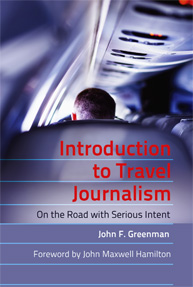Useful captions to enhance visuals
Posted: January 22, 2013 Contents: Resources | Tags: david miller, matador network, matadornetwork.com, photography, photography captions, travel journalism, travel journalist, travel photography Leave a comment »The text concludes with Resources for every travel journalist to consider taking advantage of. The matador Network’s David Miller drops another gem for the journalist. No doubt photographs have the ability to add value to a travel journalist’s work. Miller explains how to enhance these visuals with useful captions. Miller explains,
Instead of simply reducing / restating what’s already obvious in the photo, strong captions — what we at Matador call “narrative” captions — give the viewer context, backstory, information that the viewer CAN’T see for him or herself. This includes things like:
- Place names
- Subject names
- Backstory on the scene (example: at what point of the trip the shot occurred)
- Backstory or technical info on the shot itself
- Challenges or special circumstances not identifiable in the shot itself
- Information on future events the shot puts into perspective
Read…
Lead, Pitch
Posted: October 28, 2012 Contents: Chapter 4 | Tags: craft perfect pitch, david miller, lead, matador network, matadornetwork.com, perfect pitch, pitch, travel journalism, travel journalist pitch, travel writer pitch, travel writing 1 Comment »Chapter 4 teaches the travel writer about different story elements. David Miller of the Matador Network offers advice to the travel writer on how to craft a perfect pitch. Miller discusses the importance of the Lead and how ultimately a good pitch can only get the writer so far. Miller offers six ways to improve the lead of the story a few are:
- Lead with the narrator in a problematic or overtly stressful situation.
- Lead with a disarmingly simple and short declarative sentence.
- Begin in-medias-res, with descriptions placing the reader in the middle of a scene.
Remember the lead must be able to capture the readers attention to force them to read the rest of the story.
Become a better observer
Posted: October 20, 2012 Contents: Chapter 1 | Tags: active observation, become a better observer, david miller, matador network, matadornetwork.com, observation, observer, travel journalism, travel writing Leave a comment »While Chapter 1 urges the travel writer to employ more tools than just observation while investigating her story, observation is still an effective primary source of information. David Miller, at the Matador network has offered these exercises to becoming a better observer. First he discusses active observation which he states,
Active observation is trying to see the connections between what’s visible in someone (their expressions, clothes, what they’re doing) and invisible (their histories, upbringing, dreams, desires). This is key, because within the gap between what’s visible and invisible is often where the deepest, most credible, and most interesting stories are found.
To practice observations, Miller states, try these three exercises:
- Stories out of photos
- analyzing how relationships are…
The story – In three sentences or less
Posted: October 3, 2012 Contents: Chapter 6 | Tags: david miller, matador network, matadornetwork.com, micro travel notes, microblogging, travel journalism, travel journalist, travel writing Leave a comment »Chapter 6 cited microblogging — blog posts of 140 or fewer characters — as a tool for travel journalists. The Matador Network’s David Miller put out a call for something he calls Micro Travel Notes. Miller states,
“The goal was to tell a complete travel story–something with character, setting, chronology, and ideally, some kind of transformation–in three sentences or less.”
